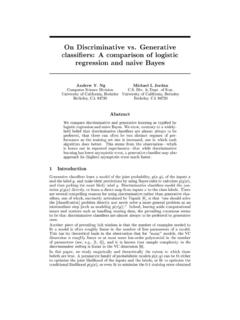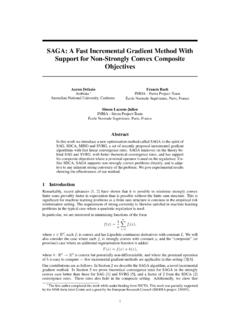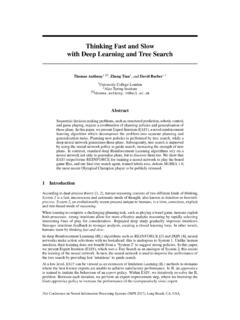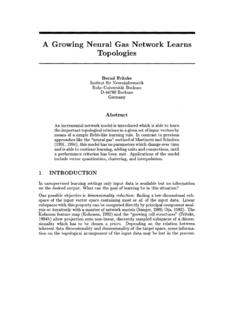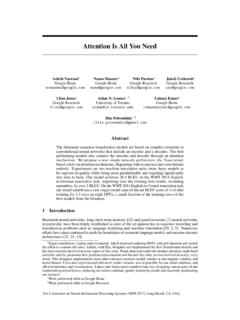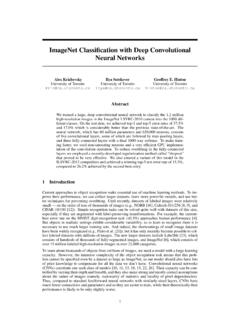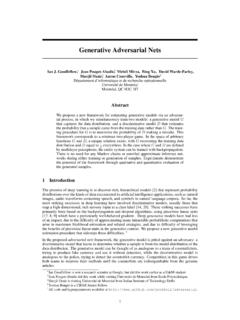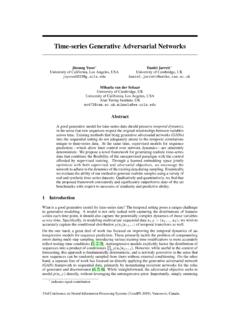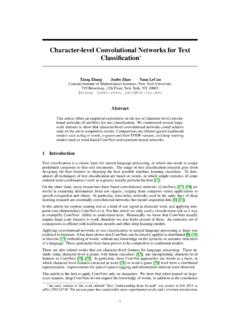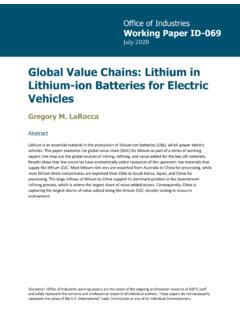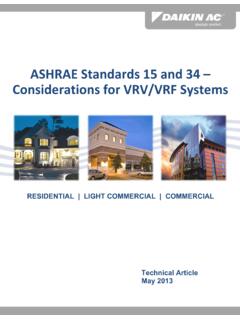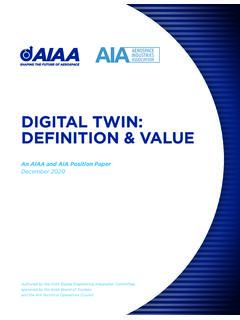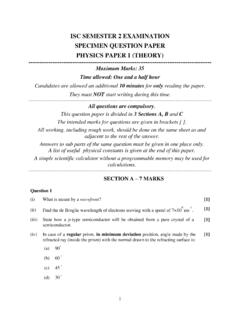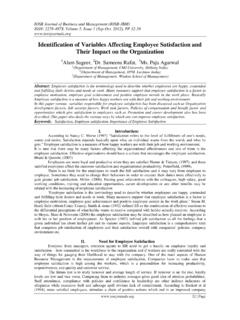Transcription of Faster R-CNN: Towards Real-Time Object Detection ... - NIPS
1 Faster R-CNN: Towards Real-Time Object Detectionwith Region Proposal NetworksShaoqing Ren Kaiming He Ross Girshick Jian SunMicrosoft Research{v-shren, kahe, rbg, Object Detection networks depend on region proposal algorithmsto hypothesize Object locations. Advances like SPPnet [7] and Fast R-CNN [5]have reduced the running time of these Detection networks, exposing region pro-posal computation as a bottleneck. In this work, we introduce aRegion Pro-posal Network(RPN) that shares full-image convolutional features with the de-tection network, thus enabling nearly cost-free region proposals.}
2 An RPN is afully-convolutional network that simultaneously predicts Object bounds and ob-jectness scores at each position . RPNs are trained end-to-end to generate high-quality region proposals, which are used by Fast R-CNN for Detection . With asimple alternating optimization, RPN and Fast R-CNN can be trained to shareconvolutional features. For the very deep VGG-16 model [19], our detectionsystem has a frame rate of 5fps (including all steps) on a GPU, while achievingstate-of-the-art Object Detection accuracy on PASCAL VOC 2007 ( mAP)and 2012 ( mAP) using 300 proposals per image.
3 Code is available IntroductionRecent advances in Object Detection are driven by the success of region proposal methods ( , [22])and region-based convolutional neural networks (R-CNNs) [6]. Although region-based CNNs werecomputationally expensive as originally developed in [6], their cost has been drastically reducedthanks to sharing convolutions across proposals [7, 5]. The latest incarnation, Fast R-CNN [5],achieves near Real-Time rates using very deep networks [19],when ignoring the time spent on regionproposals.
4 Now, proposals are the computational bottleneck in state-of-the-art Detection proposal methods typically rely on inexpensive features and economical inference Search (SS) [22], one of the most popular methods, greedily merges superpixels basedon engineered low-level features. Yet when compared to efficient Detection networks [5], SelectiveSearch is an order of magnitude slower, at 2s per image in a CPU implementation. EdgeBoxes[24] currently provides the best tradeoff between proposal quality and speed, at per , the region proposal step still consumes as much running time as the Detection may note that fast region-based CNNs take advantage of GPUs, while the region proposal meth-ods used in research are implemented on the CPU, making such runtime comparisons obvious way to accelerate proposal computation is to re-implement it for the GPU.
5 This may bean effective engineering solution, but re-implementation ignores the down-stream Detection networkand therefore misses important opportunities for sharing this paper, we show that an algorithmic change computing proposals with a deep net leadsto an elegant and effective solution, where proposal computation is nearly cost-free given the de- Shaoqing Ren is with the University of Science and Technology of China. This work was done when hewas an intern at Microsoft network s computation. To this end, we introduce novelRegion Proposal Networks(RPNs)that share convolutional layers with state-of-the-art Object Detection networks [7, 5].
6 By sharingconvolutions at test-time, the marginal cost for computing proposals is small ( , 10ms per image).Our observation is that the convolutional (conv) feature maps used by region-based detectors, likeFast R-CNN, can also be used for generating region proposals. On top of these conv features, weconstruct RPNs by adding two additional conv layers: one that encodes each conv map positioninto a short ( , 256-d) feature vector and a second that, at each conv map position , outputs anobjectness score and regressed bounds forkregion proposals relative to various scales and aspectratios at that location (k= 9is a typical value).
7 Our RPNs are thus a kind of fully-convolutional network (FCN) [14] and they can be trained end-to-end specifically for the task for generating Detection proposals. To unify RPNs with Fast R-CNN [5] Object Detection networks, we propose a simple training scheme that alternates between fine-tuningfor the region proposal task and then fine-tuning for Object Detection , while keeping the proposalsfixed. This scheme converges quickly and produces a unified network with conv features that areshared between both evaluate our method on the PASCAL VOC Detection benchmarks [4], where RPNs with FastR-CNNs produce Detection accuracy better than the strong baseline of Selective Search with FastR-CNNs.
8 Meanwhile, our method waives nearly all computational burdens of SS at test-time theeffective running time for proposals is just 10 milliseconds. Using the expensive very deep modelsof [19], our Detection method still has a frame rate of 5fps (including all steps) on a GPU, andthus is a practical Object Detection system in terms of both speed and accuracy ( mAP onPASCAL VOC 2007 and mAP on 2012). Code is available Related WorkSeveral recent papers have proposed ways of using deep networks for locating class-specific or class-agnostic bounding boxes [21, 18, 3, 20].
9 In the OverFeat method [18], a fully-connected (fc) layeris trained to predict the box coordinates for the localization task that assumes a single Object . Thefc layer is then turned into a conv layer for detecting multiple class-specific objects. The Multi-Box methods [3, 20] generate region proposals from a network whose last fc layer simultaneouslypredicts multiple ( , 800) boxes, which are used for R-CNN [6] Object Detection . Their proposalnetwork is applied on a single image or multiple large image crops ( , 224 224) [20].
10 We discussOverFeat and MultiBox in more depth later in context with our computation of convolutions [18, 7, 2, 5] has been attracting increasing attention for effi-cient, yet accurate, visual recognition. The OverFeat paper [18] computes conv features from animage pyramid for classification, localization, and Detection . Adaptively-sized pooling (SPP) [7] onshared conv feature maps is proposed for efficient region-based Object Detection [7, 16] and semanticsegmentation [2]. Fast R-CNN [5] enables end-to-end detector training on shared conv features andshows compelling accuracy and Region Proposal NetworksA Region Proposal Network (RPN) takes an image (of any size) as input and outputs a set ofrectangular Object proposals, each with an objectness model this process with a fully-convolutional network [14], which we describe in this section.
